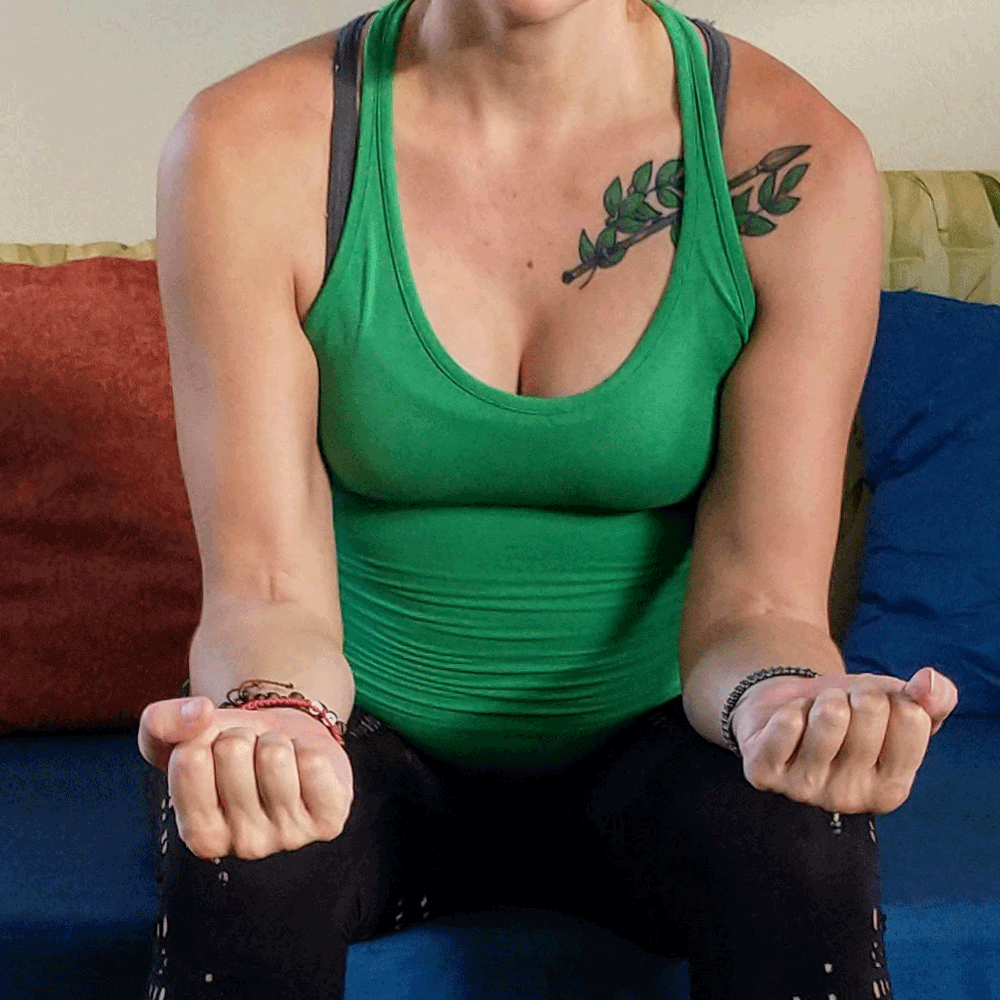4 Tennis Elbow Stretches That May Help Relieve Pain
Updated: Jun. 30, 2022
When you feel pain from your elbow to your wrist, you may be dealing with lateral epicondylitis, also known as tennis elbow. Try these stretches for pain relief.
What is tennis elbow?
Believe it or not, you don’t actually have to be a racket-carrying, tennis-whites-wearing, country club member to start feeling the effects of tennis elbow.
Pain in the elbow region is certainly associated with tennis, thanks to the overuse that these athletes place on their forearms, wrists, elbows, and shoulders. But anyone who uses their wrists and forearms a lot can end up experiencing pain.
And while wrist and forearm stretching won’t solve the problem on its own, it can be used as a part of a therapy program to help alleviate the condition’s effects.
Tennis elbow, in medical terms, is known as lateral epicondylitis.
“It’s an overuse, repetitive-stress injury to the wrist extensor tendon—a muscle group that sits on the outside of the forearm,” says Karena Wu, a physical therapist and owner of ActiveCare Physical Therapy in New York City. “It’s usually caused by working with the hands a lot [or] doing a lot of gripping activities or twisting motions with the wrist.”
So, yes, tennis players (and golfer’s) are often at risk for developing it, but so are plumbers, carpenters, painters, and cooks.
If you work with your hands a lot, the stretching routine below can help you avoid the painful condition.
(Dealing with wrist and hand pain? Try these carpal tunnel syndrome treatments.)
Using stretching to treat tennis elbow
A good sign you have tennis elbow is pain or burning on the outside of your elbow. It may radiate into your forearm and wrist. You may also have a weak grip or nighttime pain.
The reality is, when you’re experiencing an overuse injury like tennis elbow, the first step to alleviating the pain is taking a break from the activity that’s aggravating the pain.
This may not be what you want to hear, but it’s important to give the affected muscles, tendons, and ligaments the opportunity to rest and heal.
It’s also important to talk to a doctor or physical therapist about the best recovery plan for your personal situation and injury. You don’t want to spend weeks or months chasing after symptoms and trying to find some pain relief only to discover you were doing all the wrong things.
That said, stretching can help the symptoms of tennis elbow when used appropriately.
How stretching helps
“Stretching will elongate the muscles and reduce the pain from tight tissues,” says Wu.
It’ll also assist the wrist extensors, the muscles on the top of your forearm that help extend your wrist.
“Stretching of the wrist flexors [the opposite muscle group on the inside of the forearm] can alleviate the wrist extensors quickly, because this muscle group can pull the elbow out of alignment, exacerbating the effects of tennis elbow,” she says.
But it’s not just the wrist and elbow that can contribute to tennis elbow pain. Tight shoulders may also play a role.
“Overuse will occur in the elbow when range of motion in the joints either above or below the forearm are restricted. In many cases, this means the shoulder,” says Jake Harcoff, the head coach and owner of AIM Athletic in Langley, British Columbia, Canada.
You may get some relief from stretching the forearm, he says, but until you have full range of motion in your shoulder joint, symptoms will persist.
“Other than training the rotator cuff muscles, stretching the musculature of the shoulder capsule to allow more slack on the tendons of the forearm can help address the root cause of the condition,” he adds.
(Here’s how you can work to protect your joints.)
Tennis elbow stretches for pain relief
Stretching your wrist flexors and extensors is a good first step for helping alleviate irritation and pain, but it’s a good idea to include a few shoulder stretches too.
Consider the following movements.
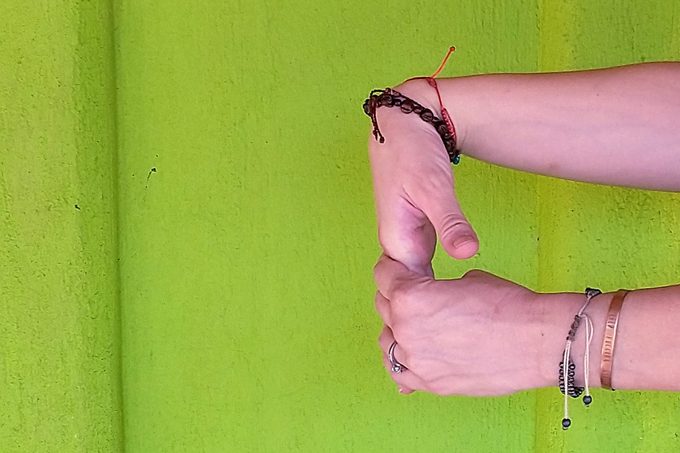
Wrist extensor stretch
To stretch the wrist extensors, you need to move your wrist to a flexed position. Extend your right arm straight out from your shoulder, your fingers pointing forward.
Flex your wrist, bending your palm and fingers so they point straight down toward the floor.
From here, use your left hand to lightly pull your fingers and hand farther into flexion until you feel a light stretch on the top of your wrist and forearm.
Hold the position for 20 to 30 seconds before releasing.
Repeat two times before switching sides.
(Don’t forget to stretch your ankles too.)
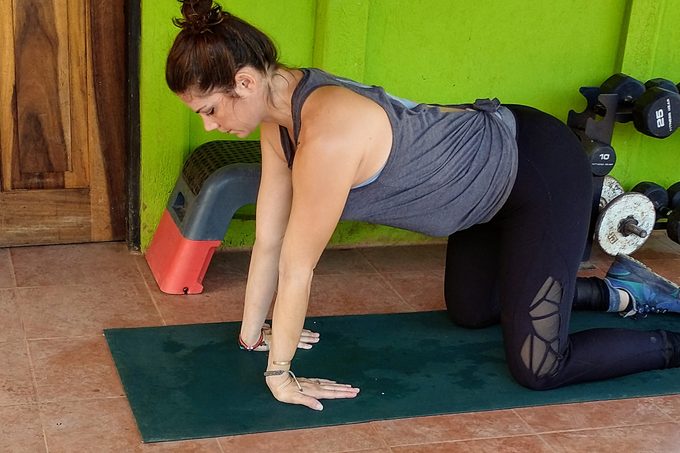
Kneeling forearm circles
Kneeling forearms circles will target your wrist flexors by placing your wrists in a hyperextended position.
Pay close attention to your personal range of motion and avoid moving to a point of pain. You should feel a slight stretch, but the movement shouldn’t be painful to perform.
Kneel on the ground in a tabletop position. Keep your knees aligned under your hips and your palms under your shoulders.
Your torso should form a straight line from hips to head. Engage your core.
Rotate your palms so your fingers are pointing toward your knees. Your wrists will be in a hyperextended position.
From here, start moving your torso in a circular motion: forward, out to the right, back toward your heels, then out to the left.
Perform five circles in one direction, then reverse the movement and perform five circles in the opposite direction.
Complete 20 circles total (alternating direction every five circles) before taking a break.
Repeat two more times.
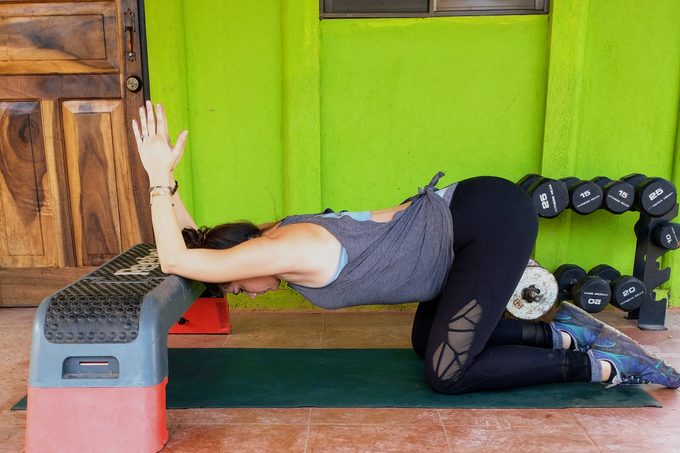
Prayer stretch on a bench
The prayer stretch, performed with your elbows propped on a bench, is an excellent way to stretch out the back of your shoulders.
Kneel on the ground in front of a bench or sturdy chair. Place your elbows on the bench, aligned directly in front of your shoulders. Press your palms together in a prayer-like position.
Engage your core so your spine remains straight from your hips to your head.
Press your hips back, extending your shoulders forward as your chest and head start lowering toward the floor. Your hips should remain lifted away from your heels, even if they’re angled downward.
Stop when you feel a nice stretch through the back of your shoulders. Hold the position for 20 to 30 seconds.
Relax, then repeat two more times.
(Here are the reasons why you may have thumb pain.)
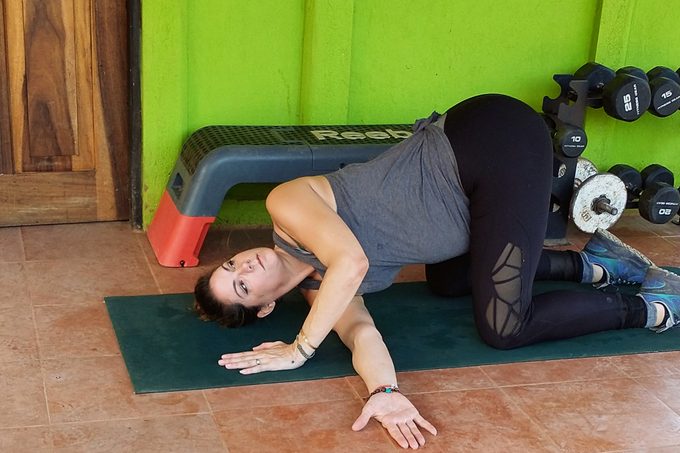
Reach-throughs
Reach-throughs are another excellent stretch to target the back and outside of your shoulders.
Start kneeling on the ground in a tabletop position. Keep your knees under your hips, your palms under your shoulders, and your core engaged.
Take a breath in. As you exhale, lift your right hand from the floor and begin rotating your torso to the left, lowering your right shoulder to the floor. Bend your left elbow as needed to facilitate this movement.
Reach your right arm under your left shoulder and across your body as far as you comfortably can go.
When you feel a nice stretch through your shoulder, stop and hold the position, relaxing as much as you can into the stretch.
Hold for 20 to 30 seconds, then reset. Perform the stretch on the opposite side.
Complete a total of three sets per side.
Next, address your rounded shoulders with these exercises.




















